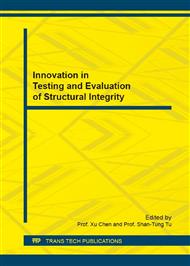p.356
p.361
p.366
p.372
p.377
p.384
p.389
p.394
p.399
Stress Analysis for the Orthotropic Pressurized Structure of Cylindrical Shell with Nozzle
Abstract:
The structure of cylindrical shell with nozzle has been widely used in pressure equipment. The analysis and design for the structure of cylindrical shell with nozzle are generally based on the isotropy of metal at present, which may cause certain error and risk. Because of the approaches of rolling, heat treatment, and so on, the materials’ properties are different along each direction in practical engineering. In this paper, based on anisotropic thin shell theory, the analysis for orthotropic pressurized structure of thin-walled cylindrical shell with nozzle was conducted by using finite element software Ansys. The influences of thickness ratio and elastic modulus ratio were comprehensively considered, and also compared with the stress results under isotropic structure. The analysis results show that the values of stress and stress concentration factor for the structure of cylindrical shell with nozzle decrease with elastic modulus ratio, but increase with thickness ratio. Compared with the influence of thickness ratio, the elastic modulus ratio has significant effect on stress level. The rational use of the material anisotropic property can optimize the structure of thin-walled cylindrical shell with nozzle. The results in present paper provided a reference for the design of orthotropic pressurized structure of cylindrical shell with nozzle.
Info:
Periodical:
Pages:
377-383
Citation:
Online since:
September 2016
Authors:
Price:
Сopyright:
© 2017 Trans Tech Publications Ltd. All Rights Reserved
Share:
Citation:


